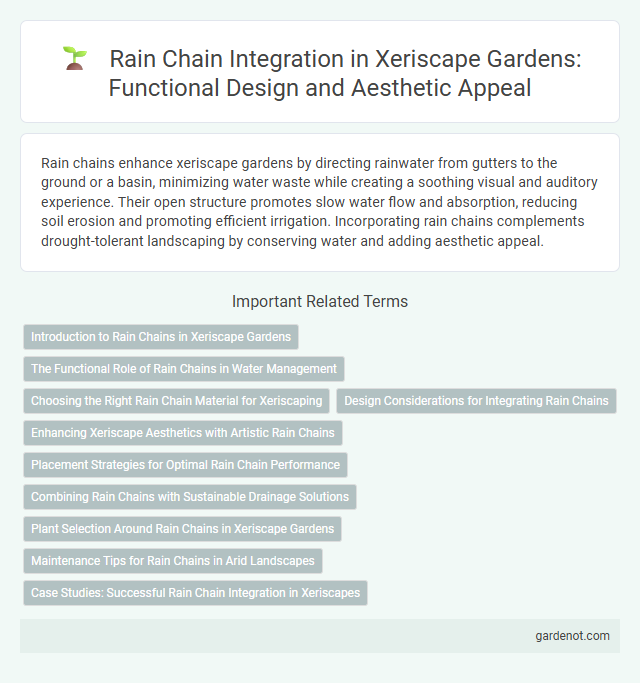Rain chains enhance xeriscape gardens by directing rainwater from gutters to the ground or a basin, minimizing water waste while creating a soothing visual and auditory experience. Their open structure promotes slow water flow and absorption, reducing soil erosion and promoting efficient irrigation. Incorporating rain chains complements drought-tolerant landscaping by conserving water and adding aesthetic appeal.
Introduction to Rain Chains in Xeriscape Gardens
Rain chains serve as a decorative and functional alternative to traditional downspouts in xeriscape gardens, guiding rainwater gently from the roof to the ground or storage containers. Made from materials such as copper or aluminum, rain chains enhance water conservation efforts by directing runoff efficiently while reducing soil erosion. Their aesthetic appeal complements drought-tolerant plants and hardscape elements, promoting sustainable landscaping practices in arid environments.
The Functional Role of Rain Chains in Water Management
Rain chains serve a critical role in xeriscape water management by directing rainwater from rooftops to garden beds or drainage areas, reducing soil erosion and promoting efficient water absorption. These chains slow the water flow, allowing it to infiltrate the soil gradually, which supports drought-resistant plants and conserves water resources. By integrating rain chains into xeriscape design, homeowners enhance sustainable landscaping while minimizing runoff and reliance on supplemental irrigation.
Choosing the Right Rain Chain Material for Xeriscaping
Selecting the appropriate rain chain material enhances xeriscaping by efficiently directing water while complementing drought-tolerant landscaping. Copper rain chains offer durability and develop a natural patina, blending seamlessly with xeric garden aesthetics. Aluminum and resin options provide lightweight, rust-resistant alternatives that balance function and design in water-conscious outdoor spaces.
Design Considerations for Integrating Rain Chains
Rain chains enhance xeriscape design by directing water flow visibly and efficiently while adding aesthetic value. When integrating rain chains, consider the chain's material durability, weight, and length to ensure proper water guidance and weather resistance. Placement near rainwater harvesting systems or permeable surfaces maximizes functionality and complements sustainable landscaping goals.
Enhancing Xeriscape Aesthetics with Artistic Rain Chains
Artistic rain chains enhance xeriscape aesthetics by transforming water flow into a visually captivating element that complements drought-tolerant landscaping. These decorative chains guide rainwater from gutters to the ground or rain barrels, combining functionality with sculptural beauty. Incorporating copper, ceramic, or stone rain chains amplifies the natural appeal of xeriscape gardens while promoting efficient water management.
Placement Strategies for Optimal Rain Chain Performance
Strategic placement of rain chains enhances their efficiency by positioning them near downspouts or roof edges where water flow is concentrated. Installing rain chains along gentle slopes or over permeable surfaces facilitates natural water infiltration and reduces soil erosion in xeriscape gardens. Optimal placement includes proximity to rain barrels or dry wells to maximize water harvesting and sustainable irrigation.
Combining Rain Chains with Sustainable Drainage Solutions
Rain chains enhance xeriscape gardens by directing rainwater efficiently into sustainable drainage systems such as permeable pavements or rain gardens, reducing runoff and promoting groundwater recharge. Integrating rain chains with bioswales improves water filtration and prevents soil erosion, aligning with low-water landscaping principles. This combination supports eco-friendly water management while adding aesthetic value to drought-tolerant landscapes.
Plant Selection Around Rain Chains in Xeriscape Gardens
Plant selection around rain chains in xeriscape gardens emphasizes drought-tolerant species such as succulents, ornamental grasses, and native wildflowers that thrive with intermittent water flow. These plants benefit from the rain chains' gentle water distribution, reducing soil erosion and promoting deep root growth. Incorporating species like sedum, lavender, and purple cone flowers enhances both aesthetic appeal and water conservation efficiency.
Maintenance Tips for Rain Chains in Arid Landscapes
Rain chains in xeriscape designs enhance water conservation while adding aesthetic appeal. Regular cleaning prevents debris buildup that can obstruct water flow, especially important in arid landscapes prone to dust and leaves. Using rust-resistant materials like copper or stainless steel ensures long-term durability under intense sun exposure and minimal rainfall.
Case Studies: Successful Rain Chain Integration in Xeriscapes
Successful rain chain integration in xeriscapes has demonstrated enhanced water management and aesthetic appeal in drought-prone regions such as Arizona and California. Case studies highlight rain chains effectively channeling water from rooftops to permeable rock beds, reducing soil erosion and promoting water infiltration. Homeowners report reduced irrigation needs by up to 30%, showcasing the rain chain's role in sustainable xeriscape design.
Rain chain feature Infographic

 gardenot.com
gardenot.com